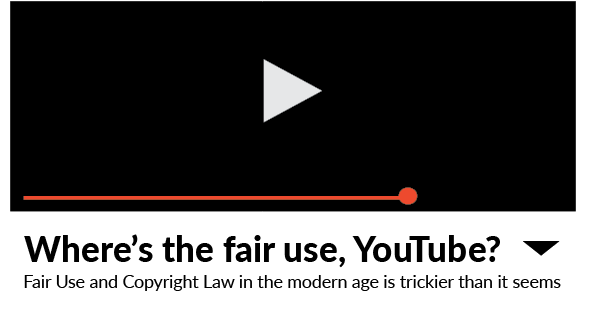
Any of you casual viewers of film review channels on YouTube might have noticed a hashtag appearing on both YouTube and Twitter: #WTFU, which was started on Channel Awesome.
It’s short for “Where’s the Fair Use?” Essentially, film reviewers are facing difficulty from YouTube and copyright holders because the reviewers are having their videos taken down for apparent copyright infringement under the DMCA (Digital Millennium Copyright Act).
From the perspective of the copyright holders, reviewers are infringing on their copyright by using clips of their material. From the perspective of the reviewers, their use of those clips falls under a qualification of copyright law called Fair Use–and they’re right.
Fair Use, briefly, is the law which allows certain leeway to the use of copyrighted material “for purposes such as criticism, comment, news reporting, teaching. . .scholarship, or research,” according to the law; the most important words here being “criticism” and “comment.”
Factors to be considered when determining Fair Use, according to Cornell University Law School include:
the purpose and character of the use, including whether such use is of a commercial nature or is for nonprofit educational purposes;
the nature of the copyrighted work;
the amount and substantiality of the portion used in relation to the copyrighted work as a whole; and
the effect of the use upon the potential market for or value of the copyrighted work.
Not all of these factors need be met, however, to qualify as fair use.
A defensible example of Fair Use would be the YouTube channel Chris Stuckmann, who uses minimal copyrighted material and provides a lot of his own commentary.
A somewhat less defensible example would be a YouTube channel called CinemaSins which shows considerable footage from the movies it criticizes, so it might lose favor on those grounds.
One very well known instance of a piece of artwork protected under Fair Use is when South Park made fun of the popular YouTube video “What What (In the Butt)” in their episode “Canada on Strike.”
This was an instance of parody, which is also generally protected under Fair Use. That’s how South Park was able to copy the original music video’s format, according to The Hollywood Reporter.
Setting all that aside, most film criticism channels (including the ones mentioned) are protected under Fair Use for the reasons I listed above.
But the dispute isn’t only over whether Fair Use is being exercised or not, the dispute is over whether YouTube is treating the copyright holders’ take-down requests correctly.
Essentially, those involved with #WTFU are angry at YouTube for allowing copyright claims to place strikes on their videos without the correct documentation. Basically, YouTube’s policy doesn’t allow for Fair Use, and that’s what they’re angry about.
This is because Youtube’s copyright policy is vague: All that’s required to claim copyright infringement is your contact information, a description of what you think is infringed, the video’s URL and a few stock statements.
“The thing is, the studios at this point know that a DMCA take down = Strike with YouTube system in place, so they are giving you a strike,” Doug Walker, also known as Nostalgia Critic, wrote on Channel Awesome.
These strikes ultimately hurt the channels who have their videos monetized. (It should be mentioned, too, that monetization does not disqualify a video from being protected under Fair Use).
Many of these reviewers’ livelihoods are dependent on their ability to make money off of their videos. If people are able to make false claims against their videos and have them get strikes, it can mean a detriment to that person’s ability to support themselves, similar to how Wired describes it.
In response to Doug Walker, YouTube CEO Susan Wojcicki said she was grateful for his input and that YouTube would look closer at the mechanisms that allowed these misuses to occur, according to Crave.
Hopefully, she’s being genuine in saying the #WTFU hashtag will generate more attention towards the squeaky wheels in YouTube’s system.
In the meantime, I suppose I could turn this into a caveat about copyright infringement on YouTube:
Before you post anything you yourself didn’t create, make sure that everything depicted is covered under Fair Use. There’s a lot of misinformation about Fair Use, so it’s up to you to educate yourself as to what falls under its protection, as I cannot cover everything in this article.
I’m 100 percent on the side of the reviewers, by the way, so let it be known I support #WTFU.
